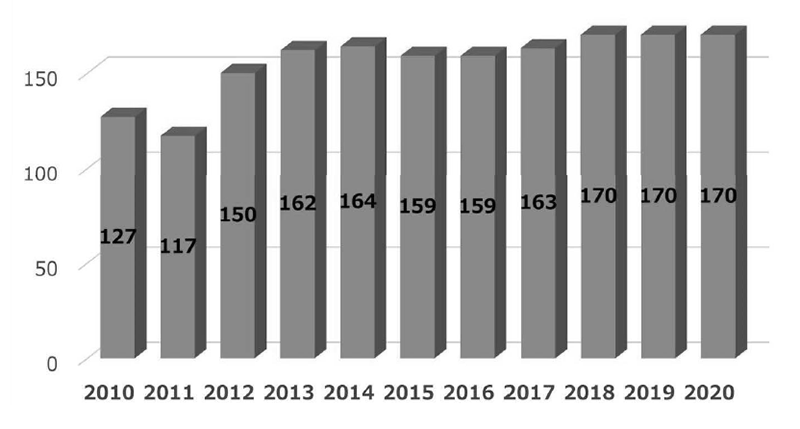Annual Report 2020
Department of Esophageal Surgery
Takeo Fujita, Hisashi Fujiwara, Kazuma Sato
Introduction
The Department of Esophageal Surgery deals with neoplasms arising from the esophagus. The surgical management of esophageal cancer has been the primary clinical and research activity of this department. In particular, our department is striving to establish minimally invasive surgery that consists of neoadjuvant treatment followed by minimally invasive esophagectomy. Our department is conducting a study to define the role of surgery in the multimodal approach to the treatment of esophageal cancer, and is aiming for thoraco-laparoscopic esophagectomy, which consists of thoracoscopic esophagectomy and laparoscopic reconstruction, to make it a standard surgical procedure.
The Team and What We Do
Our team performed 156 thoracic esophagectomies in 2020. In addition, we operated 14 cases of cervical esophageal cancer (4 cases of total laryngophayngo esophagectomy and 10 cases of larynx-preserving esophagectomies). We also focused on the postoperative care after surgery. In recent years, we have also actively introduced robot-assisted esophageal surgery to make it even less invasive, and in FY2020, approximately 40 procedures were performed using robot-assisted surgery. We held patient support multidisciplinary classroom lessons 6 times in 2020. Furthermore, regarding academic activities, we attended and delivered speech in 12 domestic academic conferences and 4 international academic conference in 2020.
Table 1. Type of procedures for thoracic esophageal cancer

Table 2. Type of procedures for cervical esophageal cancer

Figure 1.Total Number of Esophagectomies in FY2020

Research activities
To achieve the best practice for patients, we are investigating the tissue perfusion imaging study in several aspects. First, using O2 saturation imaging, we are exploring the best gastric conduit and the most suitable anastomotic site during surgery. Second, using AI deep learning technology, we are investigating AI-guided real time surgery, particularly focusing on the anatomical recognition of recurrent laryngeal nerves to avoid unexpected injury and subsequent recurrent nerve palsy, which significantly impair the patient's quality of life after surgery. Third, by including preoperative patients and their family, we are conducting a case-control trail to assess whether an active preoperative rehabilitation program with nutrition program would improve the postoperative patients' status, particularly skeletal muss index (which is vital to avoid sarcopenia), and reduce the postoperative fatigue after surgery. We are planning several other research cavities at this point. We are also currently submitting a paper on intraoperative AI analysis of the recurrent nerve.
Clinical trials
Currently, our department is investigating the role of thoracolaparoscopic esophagectomy as a minimally invasive esophagectomy that consists of thoracoscopic esophagectomy and laparoscopic reconstruction. Thoracoscopic esophagectomy in the prone position with radical lymph node dissection for patients without radical chemoradiotherapy and laparoscopic reconstruction after esophagectomy for patients without a history of laparotomy are being attempted to make them standard surgical procedures for esophageal cancer. For treating patients aged over 80 years or at high risk, a two-stage surgical procedure divided into resection and reconstruction is being attempted.
A randomized controlled phase III study comparing cisplatin and 5-fluorouracil versus cisplatin and 5-fluorouracil plus docetaxel versus cisplatin and 5-fluorouracil concurrent radiation as a neoadjuvant treatment for locally advanced esophageal cancer is ongoing. A randomized controlled phase III study of minimally invasive versus open esophagectomy for thoracic esophageal cancer (JCOG1409, MONET trial) is also ongoing.
Furthermore, a randomized controlled phase III study comparing induction treatment with cisplatin and 5-fluorouracil plus docetaxel and subsequent conversion surgery versus cisplatin and 5-fluorouracil concurrent radiation as a definitive treatment for locally advanced (cT4b or borderline tumor) esophageal cancer is ongoing. A randomized controlled phase III study of minimally invasive versus open esophagectomy for thoracic esophageal cancer (JCOG1510, TRIANgLE trial) is also ongoing. Since 2000, our department has started performing salvage surgery for patients in whom definitive chemoradiotherapy has failed. The operative procedures and postoperative management have been refined gradually. Our department is also exploring the role and efficacy of salvage surgery in the multimodal treatment of esophageal cancer.
Education
In academic training, we teach our residents not only in the aspect of surgical practice but also in academic activities for PhD courses in several aspects. One of our residents achieved a PhD degree in 2020. We are also teaching 2 PhD course students in research activities. Furthermore, one person obtained certification in endoscopic surgical techniques.
Future Prospects
We are exploring the best clinical practice for patients and their families. To achieve this mission, we are exploring the best surgical practice and future research activities in cooperation with other domestic and international research faculties.
List of papers published in 2020
Journal
1. Okada N, Fujita T, Kanamori J, Sato A, Kurita D, Horikiri Y, Sato T, Fujiwara H, Yamamoto H, Daiko H. Efficacy of prewarming prophylaxis method for intraoperative hypothermia during thoracoscopic esophagectomy. Esophagus, 17:385-391, 2020
2. Hirano Y, Fujita T, Sato K, Kurita D, Sato T, Ishiyama K, Fujiwara H, Oguma J, Daiko H. Totally Mechanical Collard Technique for Cervical Esophagogastric Anastomosis Reduces Stricture Formation Compared with Circular Stapled Anastomosis. World J Surg, 44:4175-4183, 2020
3. Daiko H, Oguma J, Fujiwara H, Ishiyama K, Kurita D, Sato T, Sato K, Faiz Z, Fujita T. Novel universally applicable technique for performing bilateral transcervical mediastinoscopic-assisted transhiatal laparoscopic esophagectomy: a truly minimally invasive procedure. Surg Endosc, 2020
4. Okada N, Fujita T, Kanamori J, Sato A, Kurita D, Horikiri Y, Sato T, Fujiwara H, Yamamoto H, Daiko H. Efficacy of prewarming prophylaxis method for intraoperative hypothermia during thoracoscopic esophagectomy. Esophagus, 2020
